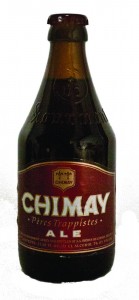This week I had the privilege of introducing some people to “good” beer. Now, while American light lager has its place, I have trouble calling anything marketed as “Cold as the Rockies” as “good.” So, I stopped and picked up a bottle of Chimay Rouge. While I haven’t had this beer in a long time, it’s hard to go wrong with a Trappist beer, as every one of them I have tasted has been both high in quality and character.
Chimay Rouge is produced by the Bières de Chimay (Chimay Brewery) located on the grounds of the Scourmont Abbey. As such, the brewery is one of the seven Trappist breweries and is in somewhat limited supply as it is produced in only limited quantities to support the brewery and select other causes. The Abbey is located in the Belgian Municipality of Chimay, and opened the brewery in 1862. The Rouge (red) bottle, marketed as “Premiere,” is the oldest of Chimay’s beers and represents a fairly dark version of the Dubbel style. Proper glassware for this style is a goblet or chalice, as these are designed to enhance the aesthetic appeal of the beer while allowing for deep draughts of their contents. Chimay Rouge will pair well with richer foods such as soft cheeses (Brie will work well) and red meats, but will not hold up against very strong foods like curries or Mexican foods. These foods, while often suggested to pair with Belgian beers, will easily overpower a Dubbel.
 The beer poured a clear, light brown color. A single finger of light tan head formed, but this rapidly settled out, leaving behind just a little bit of lacing. The aroma was slightly sweet and orange scented, with hints of yeast and lemon zest. The carbonation was quite high, but lacked the sparkly character that I’ve experienced in lighter beers or wines. After this carbonation settles out it’s actually somewhat creamy in texture. The body was moderate, lingering for a short period of time without becoming cloying. The bitterness level in this beer is quite low, but definitely perceptible. The taste was very malty and dark, but not roasted at all like a stout. The most surprising characteristic was the dry sensation up front, which switched to a sweeter finish; this was probably helped along by the high carbonation. Overall, the beer was very balanced and enjoyable.
The beer poured a clear, light brown color. A single finger of light tan head formed, but this rapidly settled out, leaving behind just a little bit of lacing. The aroma was slightly sweet and orange scented, with hints of yeast and lemon zest. The carbonation was quite high, but lacked the sparkly character that I’ve experienced in lighter beers or wines. After this carbonation settles out it’s actually somewhat creamy in texture. The body was moderate, lingering for a short period of time without becoming cloying. The bitterness level in this beer is quite low, but definitely perceptible. The taste was very malty and dark, but not roasted at all like a stout. The most surprising characteristic was the dry sensation up front, which switched to a sweeter finish; this was probably helped along by the high carbonation. Overall, the beer was very balanced and enjoyable.
All in all, this was an excellent beer, and I highly recommend giving it a shot. The Dubbel style is fairly uncommon here in America, as most Americans prefer stronger beers such as Triples and Strong Ales (bigger is better, right?), but provides a good, somewhat more restrained introduction to the Belgian styles in particular and good beers in general than the stronger styles. So, go grab a bottle, and enjoy good beer!


